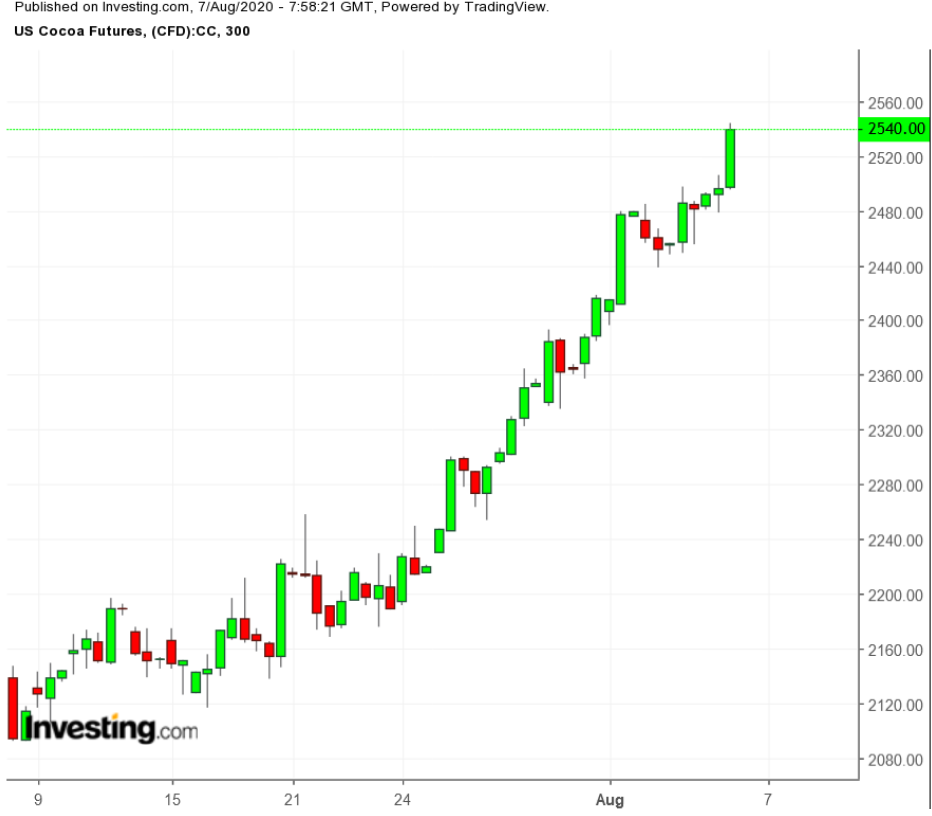In ancient Greek mythology, it’s known as the “Food of the Gods” for supposedly conferring longevity or immortality upon whoever consumed it. Indeed, investors in cocoa have been rewarded with a heavenly lift in the commodities rotational play occurring amid the coronavirus pandemic.

Between the epic 19% price drop in March when global lockdowns over the COVID-19 began—and a further 8% decline in June—cocoa prices have risen each month.

In July, the raw material for chocolate and other confections surged 7% in value. Now, for August, it’s up 4% month-to-date.
Since the collapse of the Dollar Index in March due to near-zero US rates and trillions in stimulus passed by Congress, a tidal wave of hot money has entered commodity markets seeking phenomenal returns from assets such as gold, silver and even lumber. Cocoa has been swept up in the surge too, along with arabica coffee, which was up a combined 24% in June and July before declining this month.
Investment fervor aside, analysts who study cocoa say they detect positive fundamental drivers behind its rally. But the causal effects of the push higher aren’t as clear as they should be, as the coronavirus crisis has clouded the picture for the crop with both supply and demand disrupted by the pandemic.
“There are a lot of demand worries for cocoa as the coronavirus is not going away and could be making a comeback in the US and Europe, and new lockdowns are possible,” said Jack Scoville, analyst at the Price Futures Group in Chicago.
He adds:
“Harvest is now over for the main cocoa crop in West Africa and the results are very good. The reports from West Africa imply that a big harvest has occurred in the region. Ideas are that Southeast Asia has also had good cocoa crops.”
But these are offset by concerns that supply and distribution chains from farms to the marketplace could once again be strained, though at a lesser pace than in March and April.
While chocolate, ice-cream, cookies and cocoa beverages are luxury indulgences compared to staple such as rice, they remain essential, not to mention delightful additions, to the ecological balance of our diet. Thus any constraints in their availability, due to the difficulty in the sourcing of cocoa, will be supportive to the commodity’s prices.
Farmer-friendly cooperatives, like the UK-based Co-op Group, have also been working to ensure growers get fair prices for their crop—a process that indirectly keeps cocoa futures in New York and London supported.
“As a co-operative, people are naturally at the heart of everything we do and we are committed to helping those people in our supply chain who have been worst affected by the unprecedented impacts of coronavirus,” Cathryn Higgs, head of policy at Co-op, said.
“By repurposing our funds, we are funnelling money right to the heart of where it is needed,” Higgs noted, referring to the group’s £310,000 funding under the Fairtrade label aimed at directly supporting cocoa producers around the world, including farmers in Peru, who have been impacted by the global coronavirus crisis. She added:
“Fairtrade … guarantees a fair price for the crops so when the price drops, we know that we are still paying our farmers the right price for the goods.”
Producers are also playing a waiting game in keeping prices supported, the Financial Times reported last week.
The Ivory Coast and Ghana, the two biggest producer countries, normally sell their upcoming crop ahead of the harvest starting in October, but are holding out for better prices, according to the FT report.
Borders at the Ivory Coast have been shut for four months because of the pandemic, keeping foreign farm workers out — and leaving much of the pruning and weeding work undone.
